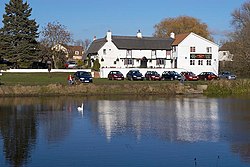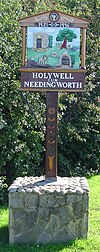Holywell, Huntingdonshire: Difference between revisions
Created page with '{{Infobox town |name=Holywell |county=Huntingdonshire |os grid ref=TL340709 |latitude=52.319 |longitude=-0.034 |post town=Huntingdon |postcode=PG27 |dialling code=01480 |LG dist…' |
m Picture |
||
| Line 2: | Line 2: | ||
|name=Holywell | |name=Holywell | ||
|county=Huntingdonshire | |county=Huntingdonshire | ||
|picture=The Ferry Boat Inn and Public House, Holywell - geograph.org.uk - 309886.jpg | |||
|picture caption=The Ferry Boat Inn, Holywell | |||
|os grid ref=TL340709 | |os grid ref=TL340709 | ||
|latitude=52.319 | |latitude=52.319 | ||
| Line 23: | Line 25: | ||
==Parish church== | ==Parish church== | ||
The church of St | The church of St John the Baptist is more than 1000 years old and has a tower built in the 16th Century with stones brought from Ramsey Abbey. | ||
The existence of a church on the site dates back further than reliable records exist, but there is a register of church rectors dating back to 990. The living was in the gift of the Abbot of Ramsey, and there remains at the west end of the village evidence of mediæval fishponds which were managed by monks from the Abbey. The current church building is mainly 14th C, with a fine 16th C tower reputedly built with stone taken from Ramsey Abbey after the Dissolution | The existence of a church on the site dates back further than reliable records exist, but there is a register of church rectors dating back to 990. The living was in the gift of the Abbot of Ramsey, and there remains at the west end of the village evidence of mediæval fishponds which were managed by monks from the Abbey. The current church building is mainly 14th C, with a fine 16th C tower reputedly built with stone taken from Ramsey Abbey after the Dissolution | ||
Latest revision as of 20:34, 3 May 2012
| Holywell | |
| Huntingdonshire | |
|---|---|
 The Ferry Boat Inn, Holywell | |
| Location | |
| Grid reference: | TL340709 |
| Location: | 52°19’8"N, 0°2’2"W |
| Data | |
| Post town: | Huntingdon |
| Postcode: | PG27 |
| Dialling code: | 01480 |
| Local Government | |
| Council: | Huntingdonshire |
Holywell is a village in Huntingdonshire, standing half a mile south of Needingworth, and east of St Ives.
Holywell is an ancient, Saxon ring village, one of just two in the county; the other being Woodhurst. It is reached by a small road from Needingworth and is a dead-end to motor traffic. There are only some 80 houses, the oldest dating to the 16th century, the parish church and a public house in the village.
The road at the southern aspect faces onto farmland and the River Great Ouse, and on the retaining banks built as a flood relief is the Old Ferry Boat, a pleasant riverside inn which is reputed to be the oldest in the country. The inn is the centre of the local legend of the maiden of ancient days who killed herself for love and walks unquiet ion the anniversary of her death.

The holy well
The well from which the village takes its name is located in front of the church, as you leave the building with the River Great Ouse ahead of you. It has been refurbished and repaired many times over the years. The well is a stone structure built over a natural spring which emerges at this point.
There are several other natural springs, or chalybeates, along Holywell Front; water seeps out under the gravel bank where it meets the underlying clay. A well dressing ceremony takes place each year in June, and children from the local primary school are involved in making floral garlands and decorations for the well.
Parish church
The church of St John the Baptist is more than 1000 years old and has a tower built in the 16th Century with stones brought from Ramsey Abbey.
The existence of a church on the site dates back further than reliable records exist, but there is a register of church rectors dating back to 990. The living was in the gift of the Abbot of Ramsey, and there remains at the west end of the village evidence of mediæval fishponds which were managed by monks from the Abbey. The current church building is mainly 14th C, with a fine 16th C tower reputedly built with stone taken from Ramsey Abbey after the Dissolution
The legends
The local legend has it that a young girl committed suicide near the church in the time of Edward the Confessor. Tradition has given her the name of Juliet Tewsley, who was a local maiden who killed herself having been jilted in love by the local woodcutter, and was thus buried on the banks of the Ouse at the ferry crossing point in 1050. It is claimed the Old Ferry Boat Inn public house was built on top of her grave. A stone slab can be found within the pub, set into the floor on the south west side of the pub.
On the anniversary of her death on St Patrick's day (17 March), according to tradition the ghost of Juliet Tewsley appears as a spectral figure slowly moving towards the river bank. Occasionally the apparition can been witnessed within the Ferry Boat Inn, but this may relate to the themed evening hosted inside, and the alcoholic drink promotions of the night. The gravestone is preserved within the pub, but to walk on it is to invite serious ill-luck and drinks must be bought for all and sundry within should a visitor do so; a useful addition for thirsty locals to add to their village’s gruesome legend.
The pub
The Old Ferry Boat Inn (or Ye Olde Ferry Boat Inn) is one of the greatest attractions to the village. It is a large public house with restaurant, conference rooms and seven large bedrooms available to the public. Over the years it has grown from a small local labourers' tavern into the commercially profitable venue that it is now. It has been owned by various families, breweries and private concerns and is seen as a jewel-in-the-crown to brewing outfits due its picture postcard looks and large visitor numbers.
The Ferry Boat Inn is one of scores of pubs in Britain to lay claim to being the country's oldest. Others include Ye Olde Trip to Jerusalem in Nottingham and Ye Olde Fighting Cocks in St Albans.
The Great Ouse
Holywell stands on the banks of the Great Ouse, which is a broad river here. The river levels are regulated by a system of locks and sluices, and after heavy rains the river is allowed to flood across the large area of meadows on Holywell Front to a depth of several feet, often covering the road. Access to the houses, which are all in an elevated position on a gravel bank running roughly east-west, is by a footpath or access track from the northern side of the village.